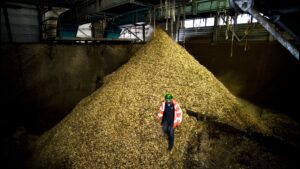Flying high on sustainable biofuels?
By Lisa Benedetti, BirdLife Europe
Look up, and chances are you’ll see a streak of white above. In 2013, over 3 billion people took a passenger flight to some destination. Oil prices are the lowest they’ve been in years, and low cost airlines are popping up everywhere, making it far easier to travel by air than ever. Although efficiencies have improved, planes still contribute about 2% of all man made CO2 emissions; it’s 3% in the EU. One of the ways the industry intends to tackle this is by replacing fossil fuels with sustainable biofuels. But is this possible?
Cutting back and finding sustainable alternatives to CO2 emitting fossil fuels will be key to helping mitigate the effects of climate change. The aviation industry intends to do their part to reduce its carbon footprint by improving the fuel efficiency of planes by about 1.5% per year from 2009 to 2020, and by halving its net CO2 emissions by 2050 relative to 2005 levels.
How do they plan to achieve this? The industry intends to replace fossil fuels with sustainable biofuels. For example, Europe has the Advanced Biofuels Flightpath initiative. It’s a project between the aviation and biofuel industries, with EC participation, to get planes using 2 million tons of biofuels by 2020. And Boeing and the Japanese aviation industry have laid out a 5 year roadmap to develop sustainable biofuels used for flights taken during the 2020 Olympic and Paralympic Games in Tokyo. A time when millions of people will fly to Japan to either participate or watch the games.
It’s true that today, some biofuels offer a low-carbon energy alternative to fossil fuels. But one should ask, where will the aviation industry get all this biofuel from and will it be truly sustainable? We know from experience that certain EU policies which have incentivized biofuel use in transport have had some damaging consequences for people and the environment.
Also, there aren’t yet any policies in place to control emissions from the aviation industry or ensure that the biofuels used are actually sustainable. To be true to intentions and meet climate targets, there must be policies in place to ensure the industry uses biofuels which emit considerably less carbon over their life cycle, including indirect effects, when compared to the fossil fuels they replace. Also, that these policies do not incentivize types of biofuel which only make climate change worse, and have social and environmental costs.
With the right commitment and investment, there may even be alternatives to biofuel on the table. SOLAR-JET, an EU funded project, has produced the world’s first ‘solar’ jet fuel using only concentrated light as a high-temperature energy source to convert water and carbon dioxide to jet fuel. So far, only a glassful has been created in the lab, but something like this is the type of disruptive technology that we need to look at. Taking the very greenhouse gas that is a major cause of global warming and turning it into a truly sustainable fuel for the future.
Photo credit: Airplane (c) Gonzalo Alonso, Flickr Creative Commons





